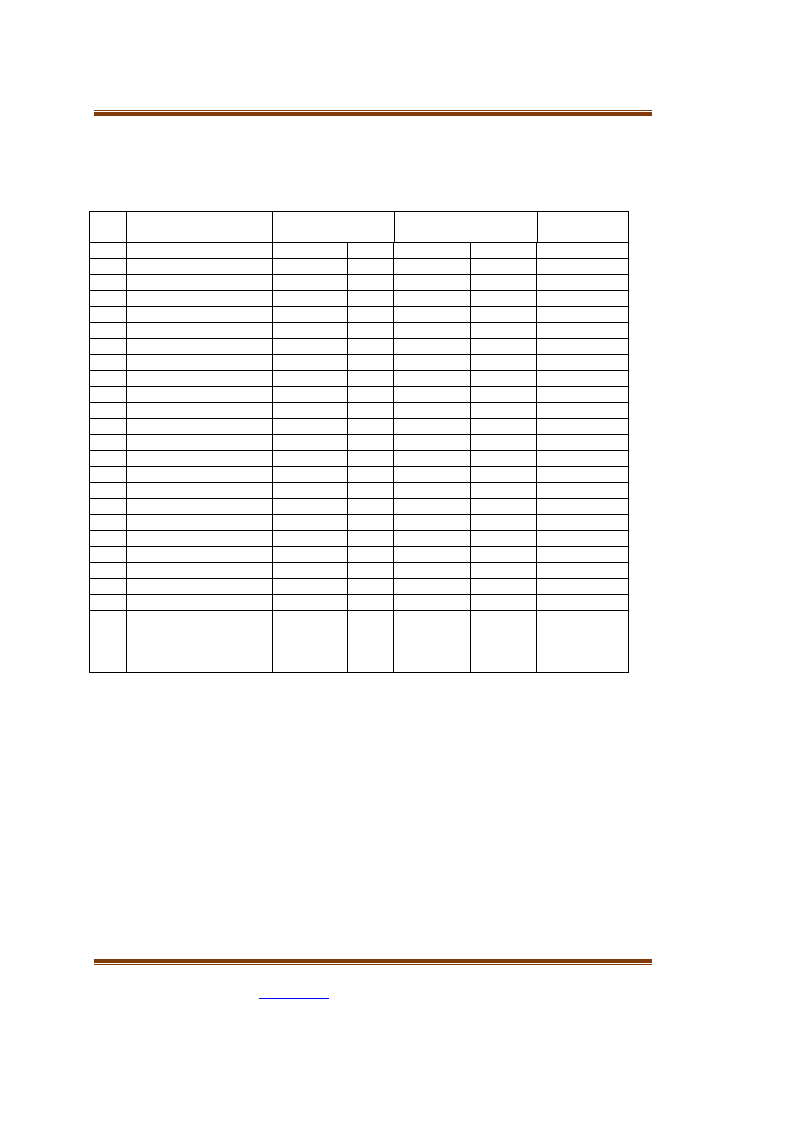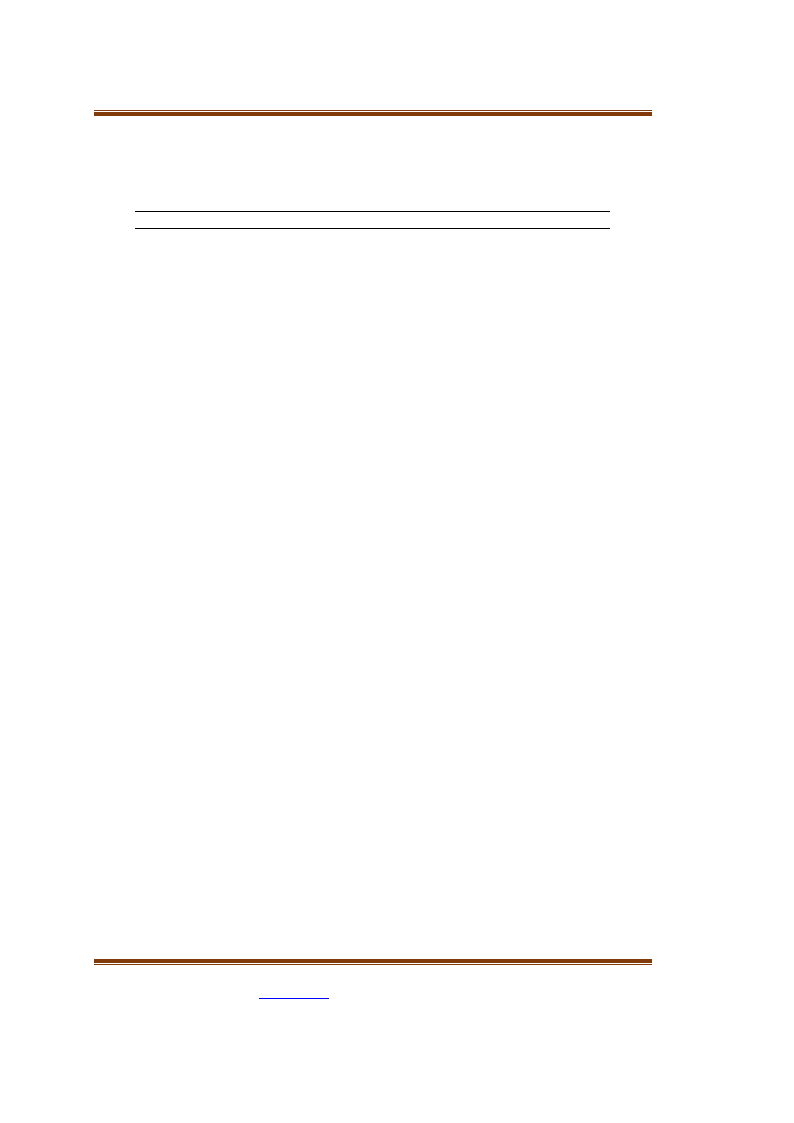
AFRREV VOL 14 (1), S/NO 57, JANUARY, 2020
African Research Review: An International
Multidisciplinary Journal, Ethiopia
AFRREV Vol. 14 (1), Serial No 57, January, 2020: 52-60
ISSN 1994-9057 (Print) ISSN 2070-0083 (Online)
DOI: http://dx.doi.org/10.4314/afrrev.v14i1.5
Assessment of Adequacy, Availability and Extent of Utilization of
Instructional Materials in the Teaching of Business Studies in
Secondary Schools in Anambra State
1Obidile, Jacinta Ifeoma & Obi, Oluchi Chinazor
Department of Technology and Vocational Education
Nnamdi Azikiwe University, Awka
Anambra State, Nigeria
1E-mail- ij.obidile@unizik.edu.ng
Phone: +2348038724558
Abstract
The need to improve the teaching and learning of Business Studies in secondary schools
necessitated this study to assess the adequacy, availability and extent of utilization of
instructional materials in the teaching and learning of Business Studies in secondary schools
in Anambra State. Three research questions guided the study. The population of the study
comprised 305 business studies teachers from 257 public secondary schools in Anambra
State. Purposive and Cluster sampling were used to select 85 Secondary schools and 120
Business Studies teachers respectively. Instruments for data collection were standardized
checklist and structure questionnaire. The checklist was used by the researchers to assess the
adequacy of the instructional materials used in the teaching of business studies while the
structured questionnaire was used to determine the availability and extent of utilization of
instructional materials in the teaching of business studies. The questionnaire was validated by
five experts with a reliability coefficient of 0.86. Data collected were analysed using
Frequency, Percentage, Mean and Standard Deviation. Findings from the study revealed that
instructional materials required in the teaching of Business Studies in secondary schools were
not adequately provided. Also, that most of the instructional materials were available but not
adequate and they were lowly utilized. Based on the findings of the study, it was
recommended among others that government and philanthropists should support public
secondary schools and made available, adequate number of the instructional materials needed
for effective teaching and learning of business studies.
Key Words – assessment; adequacy; availability; utilization; instructional materials; business
studies
COPYRIGHT © IAARR: https://www.afrrevjo.net
52
Indexed African Journals Online: www.ajol.info
Indexed Society of African Journals Editors (SAJE); https://africaneditors.org/

AFRREV VOL 14 (1), S/NO 57, JANUARY, 2020
Introduction
The use of instructional materials is indispensable in the teaching and learning process. They
are essential tools which enhance the assimilation, comprehension, application and retention
of concepts in any subject. Instructional materials are used to make teaching and learning
more meaningful and comprehensible to learners. Tamakloe, Amedale and Atta (2005)
defined instructional materials as those resources used to facilitate teaching and learning.
Bashir (2018) asserted that instructional resources are people, events, places or materials that
are used to enhance learning, usually by simplifying a difficult situation or making
uninteresting learning attractive. In the same vein Oladejo, Ojebisi and Isola (2011) described
instructional resources as human or non-human materials which a teacher uses to pass
information to learners in the classroom. According to Ubolum and Ogwunte (2017),
instructional materials are simply resources used for effective implementation of any
educational programme. In this study, instructional materials are seen as tools or equipment
used to enhance learning, understanding and acquisition of skills. What qualifies resources to
be tagged as instructional or educational is when they are used for communication and
dissemination of information in the teaching and learning environment (Nwafor&Eze, 2014).
The demand for instructional materials’ utilization in the teaching and learning of business
studies is very important as it could enhance students’ academic achievement, retention and
application of skills.
Business studies are offered at the junior and senior secondary levels where pre-vocational
and vocational subjects are offered respectively. At the junior level, students offer business
studies as an integrated subject, while at the senior secondary level, subjects such as Book-
keeping/Accounting, Economics, Store Keeping, Commerce, Typewriting/Keyboarding,
Computer Studies, Shorthand, Office Practice and Marketing are offered as Business
Education. According to Obidile and Eze (2018),business studies are subjects designed to
equip the learners with the necessary competencies needed for exposure into the world of
business. The authors maintained that the subject exposes the students to business practices so
that they could respond positively to economic realities. It equips the students with the
administrative and managerial competencies needed to adapt to the economic situations. If the
objectives of business studies are to be maximally achieved, the school system should
integrate instructional materials in the teaching and learning of business studies. Factors such
as adequacy, availability and utilization of instructional materials should be properly
addressed. It is expected that students who had offered business studies should be able to
demonstrate to a reasonable degree the skills needed for self-employment. It is worrisome that
some of the graduates of business studies could not demonstrate the required skills needed for
self-employment. This could mean that the teachers’ roles in the classroom might have failed
to equip the learners with the expected skills. This could be probably due to non-use of
instructional materials in the teaching of business studies.
Instructional materials, no matter their nature and composition, constitute important and
relevant components of successful teaching and learning (Awobodu, 2002). This position was
supported by Amuzu (2018) when the author affirmed that the inability of the teacher to
utilize appropriate instructional resources to teach certain concepts would affect the student
negatively in the subject. Utilization of instructional materials in education sector could be
influenced by their availability. However, Odo and Ezeudu (2018) noted that the functionality
of an instructional material is the proper indication of its availability. Although availability of
instructional materials is critical in the teaching and learning, utilization of these resources is
COPYRIGHT © IAARR: https://www.afrrevjo.net
53
Indexed African Journals Online: www.ajol.info
Indexed Society of African Journals Editors (SAJE); https://africaneditors.org/

AFRREV VOL 14 (1), S/NO 57, JANUARY, 2020
fundamental in ensuring quality-learning outcomes (Nwafor&Eze, 2014;
Makokha&Wanyonyi, 2015; Achimugu (2017); Dhakal, 2017). This entails that for
instructional materials to serve their purpose in enhancing students’ academic performance,
knowledge retention and application of skills, they should be functional, adequate, available,
easily accessible and properly utilized. Adequacy specifies the required number an
instructional material should be for teaching and learning to effectively take place.
Ubulom and Ogwunte (2017) noted that whenever instructional materials are utilized, they
generate greater students’ interest in the learning process. This means that teaching could be
less interesting without the use of instructional materials. According to Bongotons and
Onyenwe (2010) the use of instructional materials gives the learner opportunity to touch,
smell or taste objects in the teaching and learning process. Apart from their ability to enhance
learning, instructional materials could help teachers widen their scope of knowledge and
experience. Instructional materials required in the teaching of business studies according to
FRN (2013) include manual typewriter, computer, swivel typing chairs, drop desk/typist desk,
instructor’s table, instructor’s chair, stapling machine, stapling remover, perforator, stop
watch, wall clock, demonstration stand, English dictionary, Shorthand dictionary, filing
cabinet, filing trays, adding machine, listing machine, tape recorder, headphones, punching
machine, photocopier and any other latest office equipment in the market. Other instructional
materials listed by other scholars include pictures, filmstrips, globes, maps, transparencies,
charts, bulletin boards newspapers and magazines, tape recorder, radio, sound broadcasting,
language laboratory and gramophone, films, television, computers, videotapes and sound
strips (Amuzu, 2018).
Usman (2016) revealed that the Nigerian secondary school teachers operate from a deficient
environment where instructional materials are lacking. In the same vein, Muhammed (2017)
noted that the provision of instructional materials for teaching and learning in secondary
schools has received little attention. Furthermore, Ubulom and ogwunte (2017) revealed that
students are learning business studies without the required resources and facilities and this
might have affected their performance over the years. This study therefore sought to assess
the adequacy, availability and extent of utilization of instructional materials in the teaching of
business studies in secondary schools in Anambra State.
Research Questions
The following research questions guided the study:
1. How adequate are the instructional materials in the teaching of Business Studies in
secondary schools in Anambra State?
2. What instructional materials are available in the teaching of Business Studies in
secondary schools in Anambra State?
3. To what extent do business studies teachers utilize instructional materials in the
teaching of Business Studies in secondary schools in Anambra State?
Method
Survey research design and observation were adopted for the study. The survey research
design was used to ascertain the views and opinions of Business Studies teachers on the
availability and extent of utilization of instructional materials in the teaching of business
studies in secondary schools. Observation technique was used to assess the adequacy of
instructional materials in the teaching of business studies in secondary schools. Anambra
State was the area of the study. This area was chosen because it has relatively high number of
COPYRIGHT © IAARR: https://www.afrrevjo.net
54
Indexed African Journals Online: www.ajol.info
Indexed Society of African Journals Editors (SAJE); https://africaneditors.org/

AFRREV VOL 14 (1), S/NO 57, JANUARY, 2020
public secondary schools which were used for the study.The population of the study consisted
of 306 business studies teachers from all the 257 public secondary schools in Anambra
State.Purposive and Cluster sampling were used for the study. Purposive sampling was used
to select 85 schools for the study and cluster sampling was used to select 120 business studies
teachers from the selected schools. Cluster sampling was used because business studies
teachers were found in different schools (boys’, girls’ and mixed schools). From the 85
schools purposively selected, all the business studies teachers in those schools were used.
Instruments for data collection were standardized checklist collected from the Post Primary
School Service Commission (PPSSC, 2019) and Structured Questionnaire titled
“Questionnaire on Availability and Extent of Utilization of Instructional Materials by
Business studies Teachers (QAEUIMBST)”. The checklist was used by the researchers to
assess the adequacy of the instructional materials in the teaching of Business Studies while
the structured questionnaire was used to determine the availability and extent of utilization of
instructional materials in the teaching of business studies. The questionnaire was validated by
five experts, three experts from the Department of Technology and Vocational Education and
two experts from Measurement and Evaluation Unit, all in Nnamdi Azikiwe University
Awka. A reliability coefficient of 0.86 was established using Cronbach Alpa’s method. The
questionnaire was divided into three sections. Section A was designed to provide background
information of the respondents, Section B dealt with the availability of the instructional
materials in the teaching of business studies and Section C dealt with the extent of utilization
of instructional materials by the business studies teachers. The Heads of Business studies
teachers in each school provided the researchers information on where the instructional
materials were kept. The researchers observed the materials and the quantity available in each
school using the checklist. Copies of questionnaire were administered to business studies
teachers to seek their opinion on the availability and extent of utilization of instructional
materials in the teaching of business studies. Out of the one hundred and twenty copies of the
questionnaire distributed, one hundred and two copies were properly filled and used for the
study. The exercise lasted for six weeks. Data collected were analysed using Frequency,
Percentage, Mean and Standard Deviation. For the adequacy of the instructional materials,
any item that was available in each school up to the required number (100%) was considered
adequate, otherwise, it was not considered adequately provided. For the availability of
instructional materials, any item that had frequency and percentage up to 50 and above was
considered to be available and below 50 was not considered to be available. Furthermore,
extent of utilization was rated on a five-point scale of Very Highly Utilized (VHU) >5,
Highly Utilized (HU) >4, Moderately Utilized (MU) >3, Lowly Utilized (LU) >2 and Very
Lowly Utilized (VLU) >1.
Findings
Research Question 1: How adequate are the instructional materials in the teaching of
business studies in secondary schools in Anambra State?
Data in Table 1 show that out of 23 items listed as instructional materials recommended for
the teaching of business studies, none was adequately provided in secondary schools with the
frequency and percentage scores ranging from 46-74 and 54.12-87.06 respectively.
COPYRIGHT © IAARR: https://www.afrrevjo.net
55
Indexed African Journals Online: www.ajol.info
Indexed Society of African Journals Editors (SAJE); https://africaneditors.org/

AFRREV VOL 14 (1), S/NO 57, JANUARY, 2020
Table 1: Frequency and Percentage Scores on Adequacy of Instruction Materials in the
Teaching of Business studies in Secondary Schools
N= 85
S/N Instructional Materials Adequate
Frequency %
1. Manual typewriter
20
23.53
2. Computer
35
41.18
3. Swivel typing chairs
13
15.29
4. Drop desk/typist desk
18
21.18
5. Instructor’s table
23
27.06
6. Instructor’s chair
25
29.41
7. Stapling machine
42
49.41
8. Stapling remover
13
15.29
9. Perforator
39
45.88
10. Stop watch
32
37.65
11. Wall clock
35
41.18
12. Demonstration stand
30
35.29
13. English dictionary
32
37.65
14. Shorthand dictionary
24
28.24
15. Filing Cabinet
25
29.41
16. Filing trays
14
16.47
17. Adding machine
11
12.94
18. Listing machine
13
15.29
19. Tape recorder
23
27.06
20. Headphones
20
23.53
21. Punching machine
28
32.94
22. Photocopier
35
41.18
23. Any other latest office 12
14.11
equipment in the market
(like laminating machine,
scanner)
Not Adequate
Frequency %
65
76.47
50
58.82
72
84.71
67
78.82
62
72.94
60
70.59
43
50.59
72
84.71
46
54.12
53
62.35
50
58.82
55
64.71
53
62.35
61
71.76
60
70.59
71
83.53
74
87.06
72
84.71
62
72.94
65
76.47
57
67.06
50
58.82
73
85.89
Decision
Inadequate
Inadequate
Inadequate
Inadequate
Inadequate
Inadequate
Inadequate
Inadequate
Inadequate
Inadequate
Inadequate
Inadequate
Inadequate
Inadequate
Inadequate
Inadequate
Inadequate
Inadequate
Inadequate
Inadequate
Inadequate
Inadequate
Inadequate
Research Question 2
What instructional materials are available in the teaching of business studies in secondary
schools in Anambra State?
Data in Table 2 show that most of the instructional materials are available with frequency and
percentage scores ranging from 54-96 and 52.94-94.12 respectively. Items with frequency and
percentage scores ranging from 24-37 and 23.53-36.27 respectively are not available. They
include swivel typing chairs, stapling remover and listing machine.
COPYRIGHT © IAARR: https://www.afrrevjo.net
56
Indexed African Journals Online: www.ajol.info
Indexed Society of African Journals Editors (SAJE); https://africaneditors.org/

AFRREV VOL 14 (1), S/NO 57, JANUARY, 2020
Table 2: Respondents’ Frequency and Percentage Scores on Availability of Instructional
Materials in the Teaching of Business Studies in Secondary Schools
N= 102
S/N Instructional
Available
Not Available
Materials
Frequency % Frequency %
1. Manual typewriter
54
52.94 48
47.06
2. Computer
96
94.12 6
5.88
3. Swivel typing chairs
28
27.45 74
72.55
4. Drop desk/typist desk 54
52.94 48
47.06
5. Instructor’s table
78
76.47 24
23.53
6. Instructor’s chair
89
87.25 13
12.75
7. Stapling machine
92
90.20 10
9.80
8. Stapling remover
34
33.33 68
66.67
9. Perforator
86
84.31 16
15.69
10. Stop watch
74
72.55 28
27.45
11. Wall clock
82
80.39 20
19.61
12. Demonstration stand
58
56.86 44
43.14
13. English dictionary
86
84.31 16
15.69
14. Shorthand dictionary 69
67.65 33
32.35
15. Filing Cabinet
82
80.39 20
19.61
16. Filing trays
73
71.57 29
28.43
17. Adding machine
58
56.86 44
43.14
18. Listing machine
24
23.53 78
76.47
19. Tape recorder
67
65.69 35
34.31
20. Headphones
76
74.51 26
25.49
21. Punching machine
62
60.78 40
39.22
22. Photocopier
87
85.29 15
14.71
23. Any other latest office 68
66.67 34
33.33
equipment in the market
(like
laminating
machine, scanner)
Decision
Available
Available
Not Available
Available
Available
Available
Available
Not Available
Available
Available
Available
Available
Available
Available
Available
Available
Available
Not Available
Available
Available
Available
Available
Available
Research Question 3
To what extent do business studies teachers utilize instructional materials in the teaching of
business studies in secondary schools in Anambra State?
Data in Table 3 reveal that most of the instructional materials are lowly utilized with mean
and standard deviation ratings ranging from 2.25-2.84 and 1.12-1.26 respectively. Also, two
items are very lowly utilized with mean and standard deviation ratings ranging from 1.13-1.22
and 1.12-1.14 respectively.
COPYRIGHT © IAARR: https://www.afrrevjo.net
57
Indexed African Journals Online: www.ajol.info
Indexed Society of African Journals Editors (SAJE); https://africaneditors.org/

AFRREV VOL 14 (1), S/NO 57, JANUARY, 2020
Table 3: Respondents’ Mean Ratings on the Extent of Utilization of Instructional
Materials in the Teaching of Business Studies in Secondary Schools
N=102
S/N Instructional Materials
1. Manual typewriter
Mean SD
2.41 1.20
Remarks
LU
2. Computer
3. Swivel typing chairs
4. Drop desk/typist desk
5. Instructor’s table
6. Instructor’s chair
7. Stapling machine
8. Stapling remover
9. Perforator
10. Stop watch
11. Wall clock
3.48 1.18
2.34 1.22
2.52 1.20
4.15 1.21
4.37 1.26
3.87 1.19
1.13 1.12
3.02 1.23
2.58 1.12
3.75 1.24
MU
LU
LU
HU
HU
MU
VLU
MU
LU
MU
12. Demonstration stand
2.75 1.21
13. English dictionary
2.78
1.16
14. Shorthand dictionary
2.67
1.26
15. Filing Cabinet
3.76
1.22
16. File trays
2.25
1.20
17. Adding machine
3.31
1.21
18. Listing machine
1.22
1.14
19. Tape recorder
2.48
1.26
20. Headphones
2.36
1.12
21. Punching machine
2.42
1.20
22. Photocopier
4.32
1.46
23. Any other latest office equipment 2.84
1.16
in the market (like laminating
machine, scanner)
LU
LU
LU
MU
LU
MU
VLU
LU
LU
LU
HU
LU
Discussion of Findings
Findings of the study revealed that instructional materials were not adequately provided in the
teaching of business studies in secondary schools. The finding supports the findings of Akpan
(2005) which revealed a high level of inadequate supply of instructional materials in schools.
The inadequate provision of instructional materials could be as a result of inadequate
allocation of resources which is usually made to education sector by the nation’s
administrators and this could hinder the acquisition of skills by the students. Inadequacy of
instructional materials could also cause less interaction of students with the instructional
materials since majority of the students might not practice with the material and this might
affect their academic achievement and interest negatively since Ubulom and Ogwunte (2017)
found that the use of instructional materials generates greater students’ interest in the learning
process.
Findings of the study also revealed that most of the instructional materials required in the
teaching of business studies were available except the swivel typing chairs, stapling remover
and listing machine. This is in contrast with the findings of Okoloeze, Akubuilo, Nwahiri and
COPYRIGHT © IAARR: https://www.afrrevjo.net
58
Indexed African Journals Online: www.ajol.info
Indexed Society of African Journals Editors (SAJE); https://africaneditors.org/

AFRREV VOL 14 (1), S/NO 57, JANUARY, 2020
Anukwuorji (2017) which found that instructional materials were not available in secondary
schools.
Furthermore, the findings revealed that most of the instructional materials were lowly utilized
in the teaching of business studies. This is in line with the findings of Omeje and Chineke
(2015) which found that instructional materials were not greatly utilized in the teaching and
learning in Nigerian schools. Although low utilization of instructional materials by business
studies teachers could be as a result of not having access to the available instructional
materials. It could also be as a result of inadequate time for the lesson delivery. However,
teachers should often utilize instructional materials to enhance the teaching and learning
process.
Conclusion
The study has shown that most instructional materials required in the teaching of business
studies were not adequately provided, although some of them were available, they were lowly
utilized.
Recommendations
Based on the findings of this study, the following recommendations were made:
1. Government and philanthropists should support public secondary schools and made
available, adequate number of the instructional materials needed for effective
teaching and learning of business studies.
2. School administrators should make the available instructional materials accessible to
both the business studies teachers and their students to enhance skill development.
3. Adequate time should be allocated to the practical teaching of business studies in the
secondary schools to encourage utilization of instructional materials by the business
teachers in order to enhance the required skills for self-employment.
4. Business teachers should make personal effort to equip themselves with the necessary
skills needed for proper utilization of instructional materials as non-utilization could
inhibit the impartation of the necessary skills to students.
5. Improvised materials could be developed by students or teachers for use during
lessons where possible.
References
Achimugu, L. (2017). Availability and utilization of instructional materials for teaching
Chemistry in Senior Secondary Schools.International Journal of Novel Research in
Education and Learning 4(3), 33-43.
Akpan, A. S. (2005). Availability, adequacy and utilization of instructional materials in
Vocational/Technical institutions. Nigerian Journal of Curriculum Studies 12(1),
98-103.
Amuzu, S. (2018). Bridging the gap between theory and practice: Teachers’ utilization of
instructional resources in teaching Social Studies in Basic Schools in West
Mamprusi District in Northern Region, Ghana. International Journal of Education,
Learning and Development 6(1), 10-25.
COPYRIGHT © IAARR: https://www.afrrevjo.net
59
Indexed African Journals Online: www.ajol.info
Indexed Society of African Journals Editors (SAJE); https://africaneditors.org/

AFRREV VOL 14 (1), S/NO 57, JANUARY, 2020
Awobodu, E. D. (2002). Instructional materials and students’ academic achievement in
science subjects. Jos: Jos University Press.
Bashir, M. (2018).Adequacy and utilization of instructional materials for teaching electrical
installation and maintenance work trade in Adamawa State Technical Colleges.
Journal of Science, Technology & Education (JOSTE) 6(2), 226-233.
Dhakal, K. R. (2017). Availability and utilization of instructional materials in teaching
Geography in Secondary Schools. The Third Pole: Journal of Geography17, 51-58.
Makokha, R. N. &Wanyonyi, K. M. (2015). Utilization of instructional resources in teaching
Kiswahili poetry in Secondary Schools in Kenya. International Journal of
Academic Research in Business and Social Science5(8), 10–18.
Nwafor, C. E. &Eze, S. O. (2014). Availability and utilization of instructional materials in the
teaching of basic science in selected secondary schools in Abakaliki Education
Zone of Ebonyi State, Nigeria. Global Journal of Bio-Science and Biotechnology
3(3), 292-295.
Obidile, J. I. &Eze, P. C. (2018). Perceived effectiveness of instructional strategies for
teaching business studies in secondary schools in Anambra State. Unizik Journal of
Education Graduates 5(1), 34-40.
Odo, J. A. &Ezeudu, S. A. (2018). Availability and adequacy of instructional materials,
facilities and equipment for effective teaching and learning of mathematics in State
and Federal Colleges of Educations in South East Geopolitical Zone of Nigeria.
European Journal of Education Studies 4(4), 94-103.
Okoloeze, N. M., Akubuilo, B. N., Nwahiri, S. U. &Anukwuorji, C. A. (2017). Availability
and utilization of instructional materials in secondary schools in Awgu Local
Government of Enugu State, Nigeria. Ideal Journal of Education and Policy
Studies 1(1), 7-12.
Oladejo, M. A., Ojebisi, A. O. & Isola, O. M. (2011). Instructional materials and students’
academic achievement in Physics: Some policy implications. European Journal of
Humanities and Social Sciences 2(1), 42 – 66.
Omeje, M. O. &Chineke, S. O. (2015). Availability and the use of instructional materials in
the teaching and learning of Igbo Language. Mediterranean Journal of Social
Sciences 6(3), 286-289.
Talabi, J. K. (2003). Educational technology: Methods, tool and technology for effective
teaching. Accra: KOES Press.
Tamakloe, E. K., Amedale, E. K. & Atta, E. T. (2005). Principles and methods of teaching.
Accra: Ghana Universities Press.
Ubulom, W. J. &Ogwunte, P. C. (2017). Evaluation of instructional resources for teaching
business studies in public secondary schools in Rivers State, Nigeria. International
Journal of Innovative Education Research 2,126-132.
COPYRIGHT © IAARR: https://www.afrrevjo.net
60
Indexed African Journals Online: www.ajol.info
Indexed Society of African Journals Editors (SAJE); https://africaneditors.org/
